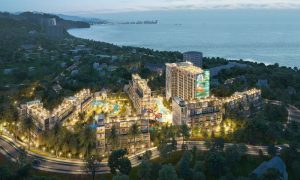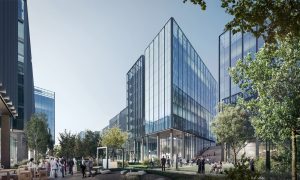Sound Advice
Last month, The Big Project teamed up with acoustics expert Paul Schwarz to investigate a reader tip-off that some Dubai Marina construction sites were breaking legal limits for the level of construction noise produced. Here are the findings, as well as some bonus tips on best practice

As we all know, construction is a noisy business and sites that fail to limit the level of sound produced during the construction process may be breaking the law, putting employees’ health at risk and causing unacceptable disruption to residents and others in vicinity of the site.
That is why when The Big Project received a tip-off from a reader in the industry that some Dubai Marina construction sites were exceeding legal building noise limits, we recruited WSP acoustic director Paul Schwarz to investigate.
Expert advice
Schwarz has a varied experience of recording and measuring sounds having worked in the worldwide acoustics sector for 15 years, moving to the UAE four years ago.
A regular speaker at the IQPC-organised GCC industry event Acoustics in Construction, he’s all too familiar with the issues surrounding industry noise pollution. As a result, he is working to create the UAE Society of Acoustic Engineers to advise authorities on the best approach to establishing and enforcing architectural and environmental noise regulations in the UAE and – eventually – across the GCC.
He explains that assessing the level of noise from a site is not as simple as one may assume: “For a full analysis, you must ensure you take a detailed snapshot over a 10-15 minute period to capture every sort of noise in the environment.
A developer receiving no complaints at all during a period of construction is very rare, anywhere in the world. Often the largest number of complaints can be a result of a lack of communication between a developer and the affected community”
“Be confident that the target of your measurement is the loudest sound you can hear. You can prove this by taking and comparing a series of measurements; one close to the road, one closer to the site, another close to an air-conditioning unit on the roof and one close to a goods loading and unloading area, for example,” he continues. Schwarz says it’s also important to address the ‘Canyon Effect’ when attempting to accurately measure noise limits.
If a building is made predominantly of glass or concrete, it is reflective. In a well built-up environment of glass or concrete buildings, sounds are bounced from one building to another, increasing noise levels.
The way sound is processed by the human brain is also worth considering. Schwarz asserts that around 90% of the population would barely be able to perceive a difference between two sources of noise up to three decibels apart.If two sources of noise were 10 decibels apart, however, these could be distinguished by up to 99% of the population, he says.
To put noise levels into perspective, it is widely believed the pain threshold is 140 decibels — equivalent to standing next to a jumbo jet — and likely to result in unrecoverable hearing damage. An average nightclub or concert would reach around 100-105 decibels, which your body may react to leaving your ears “ringing”.
[facts]
140dB
Widely believed to be the pain threshold at which hearing damage is permanent.
[/facts]
“When you hear a ringing in your ears, it’s an indication you have suffered permanent hearing damage to the membrane in your ear and you will never be that sensitive to that particular frequency again,” he reveals, adding that if you can still hear ringing the day after – you have most certainly damaged your hearing.
So how does this relate to construction? Well, those who work in an industrial settings, such as a construction site, are exposed to loud levels of noise daily, which often results in age-related hearing loss (referred to medically as Presbycusis) by the age of 50.
Site managers should aim to decrease the amount of noise produced on site to below the legal maximum limits in order to demonstrate best practice and become an employer of choice in this respect.
While many internationally-established companies reading this advice will be familiar with such good practice — many of which will have designated health, safety and environmental managers — Schwarz says there are still a large number of firms operating in the region that are failing to meet high enough standards of noise control.
In established construction markets, noise control is seen as due diligence. Companies want to be seen to be doing the right thing and demonstrate transparent processes.
“Furthermore, local authorities may enforce construction noise regulations.”
The UAE has compulsory noise-limits regulations, which must be set at the site boundary.
But Schwarz says these may be open to interpretation in the industry.
“They are not well defined, technically, when compared to markets where legislation is based on many years of research and experience, alongside advisory civil engineering or acoustic societies that have been in contact with the authorities for years.”
This inexperience is also reflected in the enforcement of regulations in the emirates. “In the US, the UK and most of Europe, authorities will have specific noise teams responding to complaints made by the public, individuals or corporations. The teams will investigate the issue using an acoustic consultant and generate a report; it’s quite a lengthy process,” he says.
But Schwarz goes onto say that the process of effectively dealing with complaints of buildingrelated noise pollution are becoming more common in the Middle East.
“I have known police officers to confiscate equipment or ask sites to suspend operations if they feel noise levels are unreasonable.”
However, he adds that without full teams and procedures in place this could be a subjective method that requires further development.
Turning it down
Until then, contractors can act responsibly by independently assessing noise levels regularly and actively working to reduce them.
“The best way to deal with any noise is at the source,” says Schwarz.
If equipment is relatively new and well maintained it will most-likely be emitting the lowest noise level it is capable of. Older machinery, piling machines and JCBs will emit a “ridiculous” amount of noise whatever the situation. In which case, staff should be provided with adequate personal protective equipment (PPE), machinery can be fitted with silencers and works can be scheduled to take place at times when they will cause the least disruption to those in the vicinity, avoiding early mornings and late nights.
Acoustic consultants help planning the phasing of work. In the UK, US and Australia, it is common for them to be engaged at an early stage, especially if the development is close to a noise-sensitive area or building of significant historical importance, but this is not yet the case in the UAE.
“For large buildings, constructing outer buildings first can create a noise barrier for the rest of the construction process. It’s all about good planning and considering practical solutions before you take the first lump of soil out of the ground,” asserts Schwarz.
Of course, he recognises that noise-reducing advice must be practical for it to be feasible. Implementing complicated noise-reduction procedures that result in a noisy task taking twice as long is not the way forward; it’s simple and easy processes, rather, that Schwarz recommends. For example, construction workers can be assigned work patterns that alternate shifts on a noisy area of a construction site with shifts on a quiet part of the site, limiting the number of hours per a day that they are exposed to phenomenal levels of noise.
To the test
Upon assessment of a number of sites in and around Dubai Marina last month, all levels of noise emitted proved to be within the legal limits set by Dubai Municipality.
Yet, Schwarz tells The Big Project it is not unusual to receive complaints about construction noise, even when contractors adhere to regulations and demonstrate best practice.
“A developer receiving no complaints at all during a period of construction is very rare, anywhere in the world,” he says.
Yet there are simple solutions: “Often the largest number of complaints can be a result of a lack of communication between a developer and the affected community.
“We have found that by simply engaging with the local community and providing information on the details of the development, the duration of the works and a place where people can go to have their opinions genuinely heard and discussed will appease a surprisingly large number of people.
“This fundamental awareness of how construction activities affect the quality of people’s lives and the basic provision of communication is, unfortunately, all too often overlooked on building sites all over the world,” he concludes.
So while the many contractors operating around Dubai Marina are not technically breaking any rules, they — and other construction companies region-wide — could still benefit from ‘sound’ advice for best practice.
The Authoritative View
“Good operating practice” construction companies should consider to reduce the likelihood of complaints from members of the public:
•Activities with the highest noise emissions should be undertaken during daytime standard working hours between Sunday and Thursday and not over the weekend or on official holidays
•Diesel-engine vehicles and compression equipment should be fitted with silencers
•Electrically-powered equipment should be preferred, where practicable, to mechanically-powered alternatives. All mechanically-powered equipment should also be fitted with suitable silencers
•Where appropriate, bored piling techniques should be considered instead of impact piling to reduce environmental noise and groundbourne vibrations. The rotating action of this piling technique significantly reduces environmental noise and groundborne vibration compared to that from impact piling
•Deliveries and waste removal from sites should be routed to minimise disturbance to local residents with full use being made of sheltered or remote access points. Entrances close to residential areas should only be used for worker and visitor access
•Delivery and heavy vehicles should be prohibited from waiting within or near the site with their engines running. The movement of heavy vehicles during the night must be avoided wherever practical
•Independent noise monitoring should be undertaken to demonstrate that noise levels at the site boundary are acceptable. This serves to protect the local community as well as the contractor and the developer against excessive noise levels, but also from unwarranted complaints
•Items of plant on site operating intermittently should be shut down in stand-by time and when not in use
•Where feasible, all stationary plant should be positioned on the construction site so that the noise impact is minimised
In addition to the above, there are also several very practical measures that a contractor or developer can adopt if considered early in the construction programming stages
•With large developments, it is possible to consider the use of site offices and storage units to provide a natural barrier to noise on site. If they are positioned directly between the noisiest activities planned for the site and the nearest affected noise-sensitive properties, then the reduction in noise can be significant
•Noise cannot always be completely eliminated, but by considering the construction of units or buildings closest to the nearest noise-sensitive properties first, completed buildings will then subsequently provide a natural barrier to noise from the construction of the rest of the development



















